|
|
|
| My Favourite Planet > English > People > Agrippina the Elder |
 |
back |
Agrippina the Elder |
|
|
| |
Agrippina the Elder
Vipsania Agrippina, commonly known as Agrippina Major or Agrippina the Elder (14 BC - 33 AD), is thought to have been born in Athens during the visit of her parents Marcus Vipsanius Agrippa and Julia the Elder to the city.
She was an important member of Rome's first imperial family, the founders of the Julio-Claudian dynasty. To say that she was well-connected would be a gross understatement: she was closely related to the first four emperors and many of the major players in Roman politics at the end of the first century BC and the beginning of the first century AD, the period when Roman Republic became an empire and the greatest power in the world. Here are some of Agrippina's relationships.
She was the:
• granddaughter of the Emperor Augustus;
• second daughter and fourth child of Augustus’ only natural daughter Julia the Elder and his close ally Marcus Vipsanius Agrippa;
• stepdaughter, sister-in-law and daughter-in-law of Emperor Tiberius;
• wife of the politician and general Germanicus (Germanicus Julius Caesar, 15 BC - 19 AD, grandson of Mark Antony, great nephew of Augustus and adopted son and heir of Tiberius);
• maternal second cousin and sister-in-law of the Emperor Claudius;
• mother of Emperor Caligula (born Gaius Julius Caesar Germanicus), as well as Nero Caesar, Drusus Caesar, Julia Agrippina (Agrippina the Younger, mother of Emperor Nero; later married her uncle Emperor Claudius, 49 AD), Julia Drusilla and Julia Livilla;
• maternal grandmother of Emperor Nero.
The relationships of this family web were made even more complicated by marriages of cousins, remarriages and official adoptions.
Agrippina was the first woman of high rank in the Roman Empire to travel with her husband on military campaigns.
She was actively involved in politics, causing the enmity of Augustus and Tiberius. In 29 AD Tiberius tried her for treason and banished her to the island of Pandataria (today Ventotene) in the Tyrrhenian Sea, where Augustus had banished her mother for adultery in 2 BC. Agrippina died on the island in 33 AD.
After the death of Tiberius in 37 AD, Agrippina's son Caligula became emperor. He personally brought his mother's ashes to Rome, had the documents of her treason trial publicly burnt, dedicated the annual Circus Games as a day to honour her and issued coins in her memory ( see photos below). The ashes were interred in her tomb in the Mausoleum of Augustus; the tombstone is now in the Capitoline Museums, Rome.
| |
References to Agrippina the Elder
on My Favourite Planet |
| |
Marble head of Agrippina the Elder from Pergamon.
Pergamon gallery 2, page 8 |
|
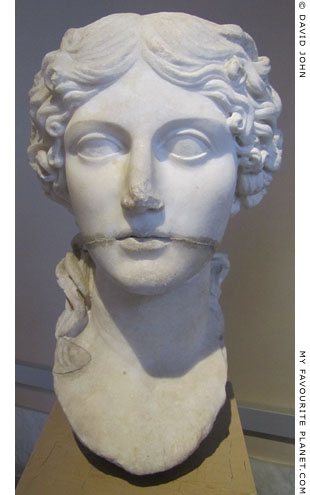
Marble head of Agrippina the Elder
from Pergamon.
First half of the 1st century AD, perhaps
on the orders of her son Emperor Caligula,
after her death in exile from Rome in 33 AD.
Found at the Sanctuary of Demeter,
Pergamon, in 1909. Height 40 cm.
Istanbul Archaeological Museum.
Inv. No. 2164 T. Cat. Mendel 557. |
| |
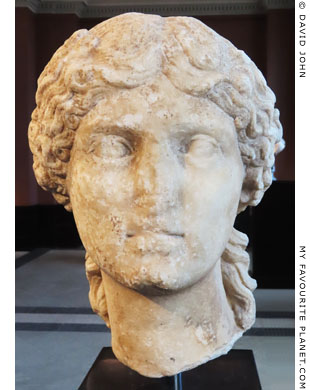
Marble head of Agrippina the Elder,
acquired in Athens in 1909.
Circa 37-41 AD. Probably Pentelic marble.
Antikenhalle (Hall of Antiquities),
Semperbau, Dresden. Inv. No. HM 351. |
| |
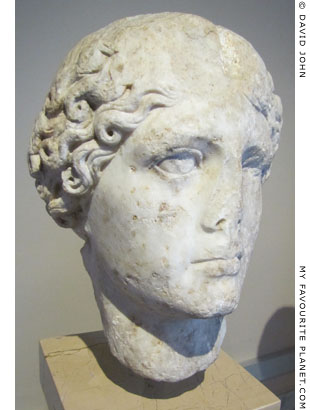
Marble head of Agrippina the Elder from
Ortahisa-Trapezus (Trabzon, Turkey).
First half of the 1st century AD.
Istanbul Archaeological Museum.
Inv. No. 4503 T. |
| |
| |
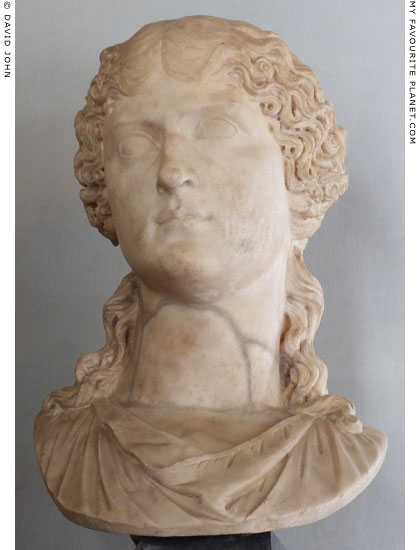
Marble bust of Agrippina the Elder.
From Rome, 10-20 AD.
Palazzo Nuovo, Capitoline Museums, Rome.
Inv. No. MC421. From the Albani Collection. |
| |
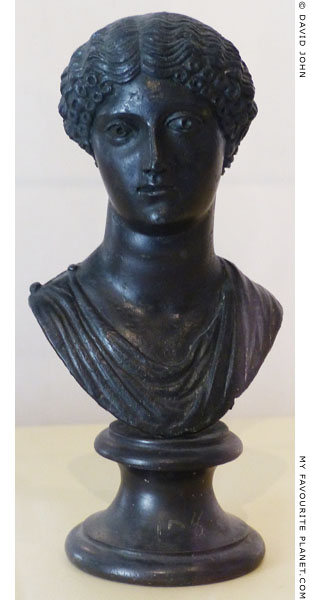
Small bronze female bust,
perhaps Agrippina the Elder.
Found in the tablinum of the
Villa of the Papyri, Herculaneum.
National Archaeological Museum, Naples. |
|
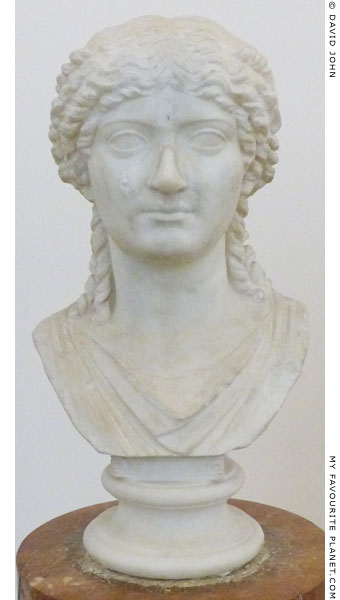
Marble portrait bust of a Julio-Claudian
princess, the so-called Agrippina. 37-41 AD.
National Archaeological Museum, Naples.
Inv. No. 6190. From the Farnese Collection. |
|
| |
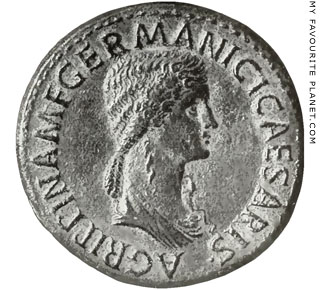 |
|
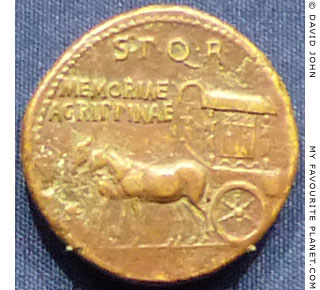 |
A bronze sestertius issued in Rome 37-41 AD by Caligula
in memory of his mother Agrippina the Elder.
Left: Obverse, showing a draped bust of Agrippina facing right. [1]
Inscription: AGRIPPINA M F GERMANICI CAESARIS
Right: Reverse, showing Agrippina's carpentum, a two-wheeled carriage
with an arched covering supported by a caryatid at each of the four
corners, and drawn by two mules. The carriage was paraded in the
procession of the games Caligula instituted in her honour.
Inscription: SPQR MEMORIAE AGRIPPINAE
Münzkabinett, Staatliche Kunstsammlungen, Dresden.
These coins varied in size and weight, but are generally 34 mm in diameter,
and weigh around 24-32 grams. Although rare, several museums own
examples, and a small number have sold at auction in recent years. |
|
| |
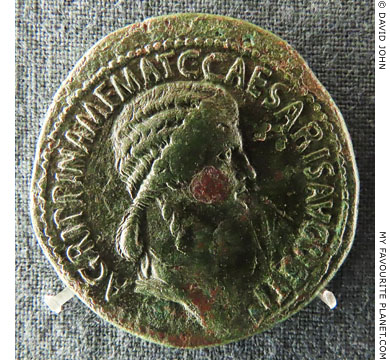
The head of Agrippina the Elder on a bronze sestertius
issued by her son Emperor Caligula, 37-41 AD.
Numismatic Museum, Athens. |
| |
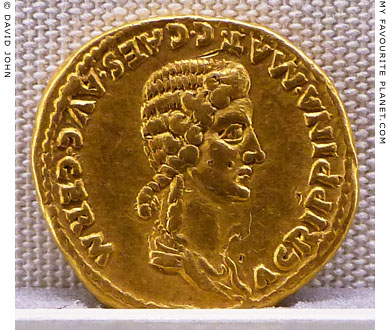
The head of Agrippina the Elder on a gold coin
issued by her son Emperor Caligula, 37-41 AD.
National Museum of Rome, Palazzo Massimo alle Terme. |
| |
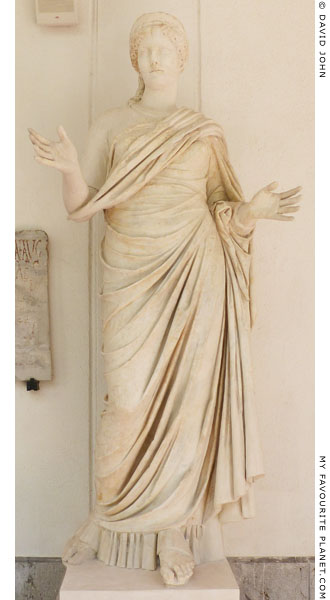 |
|
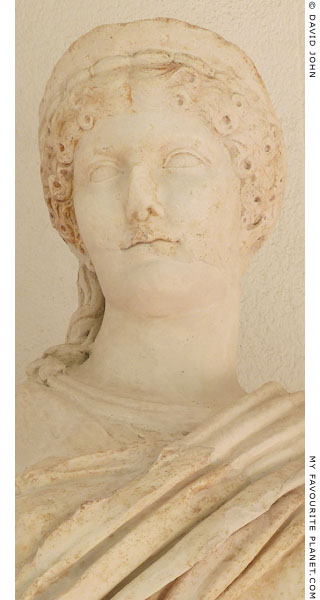 |
A marble statue of Agrippina the Elder from Tindari
(Ancient Greek, Τυνδαρίς, Tyndaris), northeast Sicily.
41-54 AD. Restored by Valerio Villareale around 1820.
Antonino Salinas Regional Archaeological Museum, Palermo, Sicily.
From the Fagan Collection (see Athens Acropolis page 15). |
|
| |
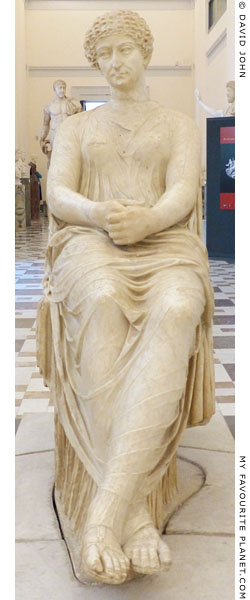 |
|
 |
The so-called "seated Agrippina" ("Agrippina seduta").
Neronian-Flavian period, 1st half of 2nd century AD.
National Archaeological Museum, Naples.
Inv. No. 6029. From the Farnese Collection.
|
|
The marble statue, which once stood in the Farnese Gardens on the Palatine Hill, Rome, was long believed to be a portrait of the mature Agrippina the Elder. This identification appears to have been based mainly on the arrangement of the hair, a style fashionable during the Julio-Claudian and Flavian periods.
The head was sculpted separately from the body, which is a Roman copy of a statue of seated Aphrodite with Eros, thought to have been made in Athens in the late 5th century BC by a sculptor in the circle of Pheidias. The original probably stood on the north slope of the Athenian Acropolis.
This is the only statue of the type in which the hands are clasped on the lap rather than with the left arm resting on the back of the throne. According to some scholars, the statue may have been commissioned as a funeral monument, perhaps for a freed slave. |
|
|
| |
Agrippina
the Elder |
Notes, references and links |
 |
|
1. Bronze sestertius with a bust of Agrippina
Image source: Guglielmo Ferrero, The women of the Caesars, translated by Christian Gauss. Loring and Mussey, New York, 1911. (There appear to be several editions by different publishers.)
Coin "from the collection of Professor G. N. Olcott". George N. Olcott (1869-1912) was a Latin professor at Columbia University who collected antiquities, particularly coins and inscriptions, for use as teaching aids. His collection of coins and squeezes is now on display at Columbia University Library. |
|
|
| |
Photos on this page were taken during
visits to the following museums:
Germany
Dresden, Staatliche Kunstsammlungen, Münzkabinett
Dresden, Semperbau, Antikenhalle (Hall of Antiquities)
Greece
Athens, Numismatic Museum
Italy
Naples, National Archaeological Museum
Rome, Capitoline Museums, Palazzo Nuovo
Rome, National Museum of Rome, Palazzo Massimo alle Terme
Italy - Sicily
Palermo, Antonino Salinas Regional Archaeological Museum
Turkey
Istanbul Archaeological Museum
United Kingdom
London, British Museum
Many thanks to the staff of these museums. |
|
|
| Photos and articles © David John, except where otherwise specified. |
 |
Visit the My Favourite Planet Group on Facebook.
Join the group, write a message or comment,
post photos and videos, start a discussion... |
|
|
| |
|
|
| |
| |
 |
| |
 |
| |
 |
| |
 |
| |
 |
| |
 |
| |
George Alvanos
rooms in
Kavala's historic Panagia District
Anthemiou 35,
Kavala, Greece
kavalarooms.gr
|
| |
Olive Garden Restaurant
Kastellorizo,
Greece
+30 22460 49 109
kastellorizo.de
|
| |
Papoutsis
Travel Agency
Kastellorizo,
Greece
+30 22460 49 286
greeklodgings.gr
|
| |
|